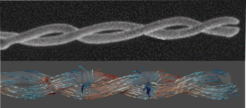3D printed nanomagnets unveil a world of patterns in the magnetic field
Nanoscale magnetic double helices are found to host highly coupled textures
Scientists have used state-of-the-art 3D printing and microscopy to provide a new glimpse of what happens when taking magnets to three-dimensions on the nanoscale – 1000 times smaller than a human hair.
The international team led by Claire Donnelly, the leader of our Institute’s new independent group, Spin3D, formerly of the University of Cambridge, used an advanced 3D printing technique they developed to create magnetic double helices – like the double helix of DNA – which twist around one another, combining curvature, chirality, and strong magnetic field interactions between the helices. Doing so, the scientists discovered that these magnetic double helices produce nanoscale topological textures in the magnetic field, something that had never been seen before, opening the door to the next generation of magnetic devices. The results are published in Nature Nanotechnology.
Magnetic devices impact many different parts of our societies, magnets are used for the generation of energy, for data storage and computing. But magnetic computing devices are fast approaching their shrinking limit in two-dimensional systems. For the next generation of computing, there is growing interest in moving to three dimensions, where not only can higher densities be achieved with 3D nanowire architectures, but three-dimensional geometries can change the magnetic properties and offer new functionalities.
Since the first proposal of the racetrack memory by Stuart Parkin, leader of the MPI of Microstructure Physics in Halle, there has been growing interest in the storage of digital data in magnetic nanowires to produce information storage devices with high reliability, performance and capacity. However, this idea has always been very difficult to realise, because not only do scientists need to be able to make three-dimensional magnetic systems, they also need to understand the effect of going to three dimensions on both the magnetisation and the magnetic field.
As a result, over the last few years the team has been focusing on developing new methods to visualize three dimensional magnetic structures - think about a CT scan in a hospital, but for magnets. They have also developed a 3D printing technique for magnetic materials.
Here, the 3D measurements were performed at the PolLux beamline of the Swiss Light Source at the Paul Scherrer Institute, currently the only beamline able to offer soft X-ray laminography. Using these advanced X-ray imaging techniques, the researchers observed that the 3D DNA structure leads to a different texture in the magnetisation compared to what is seen in 2D. Pairs of walls between magnetic domains (regions where the magnetisation all points in the same direction) in neighbouring helices are highly coupled – and as a result, deform. These walls attract one another and, because of the 3D structure, rotate, “locking” into place and forming strong, regular bonds, similar to the base pairs in DNA.
Not only did they find that the 3D structure leads to interesting topological nanotextures in the magnetisation, where such textures are seen relatively often, but also in the magnetic stray field, which revealed exciting new nanoscale field configurations! This new ability to pattern the magnetic field at this length scale would allow the definition of what forces will be applied to magnetic materials and to understand how far one can go with patterning these magnetic fields.
Having gone from two to three dimensions in terms of the magnetisation, now Donnelly and her collaborators from the Paul Scherrer Institute and the Universities of Glasgow, Zaragoza, Oviedo, and Vienna will explore the full potential of going from two to three dimensions in terms of the magnetic field.
The prospects of this work are manyfold: these strongly bonded textures in the magnetic helices promise highly robust motion and could be a potential carrier of information. However, even more exciting is this new potential to pattern the magnetic field at the nanoscale, this could offer new possibilities for particle trapping, imaging techniques as well as smart materials.
Text: © Vanessa Bismuth (VB), University of Cambridge













